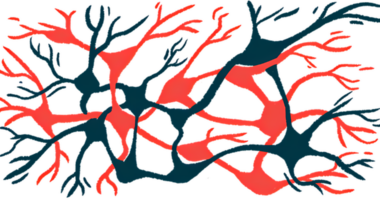Scientists may have found way to prevent constipation in Parkinson’s
Meds to treat spinal cord signaling issues may help patients: Study

Interactions between receptors for ghrelin, the so-called hunger hormone, and the chemical signaling molecule dopamine may go awry in Parkinson’s disease, potentially leading to chronic constipation — a symptom that the Australian scientists behind this new research called “debilitating” for many people with the condition.
To learn more about the causes of constipation among Parkinson’s patients, a research team from the University of Queensland, led by Sebastian Furness, PhD, investigated the molecular mechanisms in the spinal cord that support voluntary defecation.
The scientists found that, without the background activity of a receptor protein that recognizes ghrelin, dopamine signaling pathways can’t properly activate. Dopamine is a neurotransmitter — a signaling molecule that nerve cells use to communicate with each other and the rest of the body — that is progressively lost in Parkinson’s disease.
Based on these findings, the team hypothesized that a medication that mimics ghrelin could ease constipation in people with Parkinson’s.
“We’re translating this knowledge about normal physiology into a major step [toward] improving the quality of life for people with Parkinson’s disease, a neurodegenerative disorder that causes chronic constipation in up to 90 percent of patients,” Furness said in a university news story. “This discovery might allow us to substantially improve the lives [of] people living with Parkinson’s disease.”
Furness’ research group has been awarded $3 million by the U.S. Department of War to pursue this clinical translation, according to the university.
The study, “Constitutive ghrelin receptor activity enables reversal of dopamine D2 receptor signaling,” was published in the journal Molecular Cell.
In Parkinson’s, the nerve cells in the brain — called dopaminergic neurons — that produce dopamine progressively die. This causes motor and nonmotor symptoms, the latter of which may include digestive problems such as constipation.
Study uncovers mechanisms underlying constipation in Parkinson’s
Although treatments are available to help ease certain Parkinson’s symptoms, they typically don’t address constipation.
“Chronic constipation is debilitating and is one of the biggest factors for reduction in the quality of life for people with Parkinson’s because it is poorly managed by current approaches,” Furness said.
Moreover, dysfunction in the area of the spinal cord called the spinal defecation center could contribute to constipation in Parkinson’s, Furness noted.
Dopaminergic neurons in the spinal defecation center help initiate bowel movements. In Parkinson’s disease, broader changes in the nervous system may disrupt this signaling, interfering with voluntary defecation control, according to the researchers.
Understanding the mechanisms of this signaling could help scientists identify changes in Parkinson’s and develop new therapies. In this work study, Furness and his team investigated these mechanisms at a molecular level.
Previous research has suggested that in the spinal defecation center, dopamine binds to the dopamine D2 receptor (DRD2) protein on spinal cord neurons. This causes the neurons to activate, sending signals to the relevant muscles. However, DRD2 alone can’t initiate and control bowel movements.
“We’ve shown that to work properly in this setting [the dopamine receptor] needs a partner, and that partner is the receptor for ghrelin,” Furness said.
Chronic constipation is debilitating and is one of the biggest factors for reduction in the quality of life for people with Parkinson’s because it is poorly managed by current approaches.
The ghrelin receptor (GHSR) is similar to DRD2. When ghrelin binds to GHSR, the receptor is activated, causing neural activation. However, even without ghrelin binding, the receptor participates in some background signaling activity.
To confirm this partnership between DRD2 and GHSR, the team exposed neurons with both receptors to dopamine. As expected, the neurons were activated. In neurons genetically engineered to have DRD2 but not GHSR, exposure to dopamine failed to produce this activation.
Using computer models and cellular studies, the researchers demonstrated that it was unlikely that DRD2 and GHSR physically interact. This suggested there may be an alternative explanation for why GHSR needs to be present. The team hypothesized that GHSR’s background activity was a requirement for dopamine activation in this context.
Next step for researchers: Exploring medicines targeting the ghrelin receptor
To test this theory, the scientists engineered neurons to have a mutated version of GHSR that doesn’t participate in background activity. Exposing these cells to dopamine didn’t produce activation, supporting their theory, according to the researchers.
Based on these findings, the team developed a model to explain signaling mechanisms in the spinal defecation center. They suggested that background GHSR activity primes neurons, creating a specific signaling environment. Then, when the neurons receive dopamine signals, the dopamine is able to activate the cells.
Parkinson’s may disrupt this specific signaling environment, making it more challenging to control defecation, according to Furness.
“Our research suggests targeting the ghrelin receptor could overcome [these] changes in the spinal defecation control pathway,” Furness said.
Previously, a short-term Phase 2 clinical trial (NCT01781104) demonstrated that a molecule called relamorelin that binds to GHSR accelerates colonic transit in people with chronic constipation. Furness and the research team suggested a similar approach for people with Parkinson’s who experience constipation.
“We will now explore how medicines targeting the ghrelin receptor may help coordinate voluntary defecation and alleviate chronic constipation for people with Parkinson’s disease,” Furness said. “Our work has led to a new explanation for chronic constipation in Parkinson’s.”








